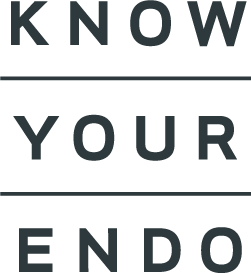We are big believers in a holistic approach to managing endometriosis with diet and lifestyle tools. But no matter how well you eat and or how long you meditate, it's critical to receive checkups with your doctor. These are simply tools to help manage your symptoms, not a cure or a treatment. See more about this in our Ask A Dr. section.
There is no cure for endometriosis.
But what if there were tools to help manage it? What if you could have more good days than bad?
What if you could feel 20%, 30%, or even 80% better each day? It would be worth a shot, right?
Diet + Nutrition
There are lots of diets out there. Doctors and nutritionists have spent years debating the best diet for overall health. There’s so much information out there that it’s hard to find a single theory that everyone can agree on. But one idea remains pretty consistent in every camp: inflammatory foods are not our friends, especially for those with endometriosis.
Let’s think about it for a second. With endo, your insides are already pretty inflamed, right? Adding inflammatory foods is only adding fuel to the fire.
What are inflammatory foods?
Processed and packaged foods
Dairy products (milk, cheese, yogurt)
Red meat
Soy
Refined sugar
Fried foods
Soda
Refined carbohydrates and wheat (pastries, white bread)
Alcohol
Caffeine
* Some people also experience inflammation, pain, or symptoms from eating eggs, grains, corn, soy, and nightshade vegetables (eggplant, peppers, tomatoes, and potatoes).
What's a whole foods plant-heavy diet?
Whole foods are foods that are minimally processed or not processed at all - veggies, fruits, nuts, seeds, grains, and legumes. Plant-based means that these foods come from the ground/trees and are not derived from animals (although many plant-based eaters consume honey). So if you're eating with endo in mind, the goal is to rid your diet of all those inflammatory foods and replace them with ones that make your endo happier.
So what can I eat?
You can eat whatever you want. We're not here to judge. But if inflammatory foods are making your symptoms worse, it might be worth making some changes. A lot of people with endometriosis experience a significant decrease in their pain and symptoms by ditching inflammatory foods and adopting a whole foods plant-heavy diet.
I'm nervous/skeptical about this diet. Where do I start?
Understandable. There are lots of doctors that don't discuss nutrition with their endo patients, so this might be new to you. There's also a lot of emotion and tradition tied to food (we understand this more than you know). A good place to start is with your next meal. Create a recipe or go out for a plant-based meal that you're truly excited about, not just one that sounds "healthy." Take it slow and feel proud of all the progress you make.
One Part Plant is a great book to guide you in starting a plant-based diet, written by someone that has been through it (Jessica Murnane, founder of Know Your Endo, is the author!). It has super-easy recipes, shopping ideas, advice on social situations, tips for working through emotions, and helpful info on the powerful relationship between food and endometriosis.
Lifestyle Tools + Practices
If you're a person living with endometriosis, taking care of yourself needs to be your number one priority. That might sound selfish, since most our plates are already full of commitments and family/work/school responsibilities. And when you have endo, just making it out of bed some mornings can feel like a part-time job. But if you don't give your body the care it craves, things will not get better and can potentially result in even worse symptoms and pain. Still not convinced? Remember, the better you take care of yourself, the better you'll be able to care for others in your life.
Creating endo lifestyle tools is the best way to begin to take charge of your health. There’s no one specific tool that is the best tool to manage your endo pain and symptoms. Nope. We need a few tools that work together, and that collection of tools might be different for everyone.
I'm in too much pain/too tired to even get out of bed. How am I supposed to exercise and cook for myself?
It might take a little time to get there, but small steps add up to giant leaps. Moving your body doesn't have to mean running a marathon. It can mean stretching in bed or walking around the block. You can purchase ready-made whole food meals from the store if cooking is too tough. Start with a small step and go from there. We believe in the power of these tools and believe in you.
What are lifestyle tools?*
Diet and nutrition (see above)
Massage
Exercise
Stress-management hobbies + activities
Therapy
Natural Products
Chinese Medicine (acupuncture + herbs)
CBD/Cannabis
*These tools are not a cure for endo and will work differently
for every person. Please remember to get regular checkups
with your doctor.
This sounds expensive.
What if I'm on a budget?
We totally get that not everyone can afford a monthly massage or a membership to a yoga studio. But you can still care for yourself in simple ways.
Simple ways like taking a shower, eating whole food meals, letting yourself have a pajama day, laughing (and crying), using less chemicals/toxins in your life, taking a break from your phone, sitting in silence for 10 minutes with your eyes closed, or doing a yoga class on YouTube.
I need more help with this tool thing.
The Know Your Endo book will be published on April 27th, 2021 with Avery (an imprint of Penguin Random House). You can pre-order here!



